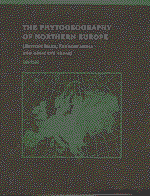Book contents
- Frontmatter
- Contents
- Preface
- Acknowledgements
- 1 Introduction
- 2 Climate
- 3 Edaphic factors
- 4 The geological history of the present European flora
- 5 The atlantic and oceanic elements
- 6 The thermophilic element
- 7 The boreal element
- 8 The arctic, alpine and montane elements
- 9 Endemic, disjunct and centric distribution patterns
- 10 Anthropochorous plants
- Appendix I Calculation of climatic parameters for comparison with plant distributional data
- Appendix II The Northern European species of Flora Europaea with indications of their status and climatic correlations
- Appendix III Arctic species of vascular plants
- Appendix IV Endemic species of vascular plants, bryophytes and lichens
- Appendix V Extra-European disjunctions – bryophytes and lichens
- References
- Index
10 - Anthropochorous plants
Published online by Cambridge University Press: 23 October 2009
- Frontmatter
- Contents
- Preface
- Acknowledgements
- 1 Introduction
- 2 Climate
- 3 Edaphic factors
- 4 The geological history of the present European flora
- 5 The atlantic and oceanic elements
- 6 The thermophilic element
- 7 The boreal element
- 8 The arctic, alpine and montane elements
- 9 Endemic, disjunct and centric distribution patterns
- 10 Anthropochorous plants
- Appendix I Calculation of climatic parameters for comparison with plant distributional data
- Appendix II The Northern European species of Flora Europaea with indications of their status and climatic correlations
- Appendix III Arctic species of vascular plants
- Appendix IV Endemic species of vascular plants, bryophytes and lichens
- Appendix V Extra-European disjunctions – bryophytes and lichens
- References
- Index
Summary
Plants that benefit from human activities and thereby increase their population size or geographical area are termed synanthropic or hemerophilous. This includes weeds in fields or gardens, also called agrestals or segetals, and ruderals that occupy areas where human activity has disturbed the natural vegetation in abandoned plots, along roads or railways, etc. Weeds are mostly annual, whereas ruderals are mostly perennial.
Phytogeographical problems of anthropochorous plants have been treated by Linkola (1916, 1921), Jessen & Lind (1923), Salisbury (1961), Berglund (1966a, b), Godwin (1975), Holzner & Numata (1982), Mucina et al. (1984), Willerding (1986), Di Castri et al. (1987), Kornek & Sukopp (1988) and Sukopp & Hejny (1990). The role of man in European vegetation history has been summarised by Behre (1988).
Before the advent of agriculture in the Neolithic period man lived as a hunter-gatherer and his impact on the flora was different from animals in only a few ways. He contributed to the dispersal of diaspores and no doubt encouraged growth of some species around his habitations as some species benefit from the addition of nitrogen and phosphorus to the soils. The use of fire may also have affected the vegetation, but we know little about this.
With the advent of agriculture, the effects became more important. The first agriculturalists used fire as a means to clear the vegetation. Trees were felled with stone axes and the slash thus produced was burnt. The previous vegetation was thus destroyed and the ash enriched the soils with plant nutrients.
- Type
- Chapter
- Information
- The Phytogeography of Northern EuropeBritish Isles, Fennoscandia, and Adjacent Areas, pp. 149 - 156Publisher: Cambridge University PressPrint publication year: 1998

